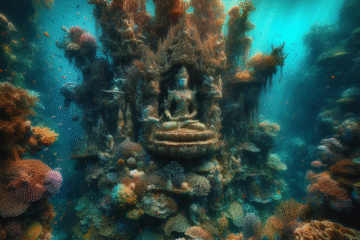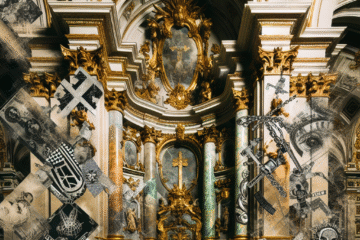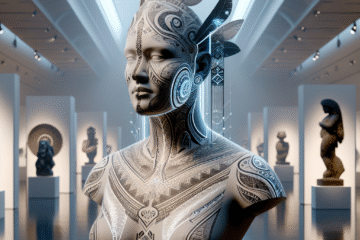
Introduction: Kafka’s Shadow in Oil and Ink
In the dim corridors of Cold War Eastern Europe, between the echoing typewriters and rubber stamps of endless paperwork, a distinct form of visual art emerged—one haunted not by ghosts but by documents, desks, and dizzying systems of bureaucracy. In Czechoslovakia and Poland, where the state apparatus loomed large and omnipresent, artists turned to surrealism not as a flight from reality but as a confrontation with it. They channeled the absurdity, anxiety, and alienation of their daily lives into haunting, dreamlike images reminiscent of Kafka’s literary despair—images as visually arresting and psychologically unsettling as anything ever conjured by Salvador Dalí.
1. The Post-War Palette: Trauma and Transition (1945–1955)
In the immediate aftermath of World War II, Eastern European nations found themselves under the iron grip of Soviet influence. The Socialist Realism mandated by official cultural policies aimed to produce optimistic portrayals of workers and industrial progress. Yet underneath this state-sanctioned façade, artists simmered with personal and collective trauma. In both Poland and Czechoslovakia, many painters covertly began to encode deeper meanings into their work—an illicit surrealism born not in Parisian cafés, but in gray offices and silent factories.
Artists like Czech surrealist Josef Istler cloaked critiques of state machinery in abstract forms and biomorphic shapes, defiant of both political repression and artistic orthodoxy. Meanwhile in Poland, Andrzej Wróblewski’s split-format paintings—such as his “Execution” series—combined the figurative with the fragmented to convey psychological rupture. Though these pieces were not always explicitly bureaucratic, the sense of existential confusion mirrored the Kafkaesque struggle of post-war life under surveillance and suspicion.
2. 1960s Dissent: The Rise of Conceptual Surrealism
By the 1960s, a younger generation of artists sought new methods to express their disenchantment. As censorship intensified, so too did the inventiveness of metaphor. Polish conceptual artist Tadeusz Kantor began experimenting with theatrical installations and collages that embedded discarded office furniture, rusted briefcases, and yellowing documents. His “Emballages”—literal wrappings or shrouds of everyday objects—suggested a suffocating entrapment, recalling how bureaucracy smothers individuality.
In Czechoslovakia, the Prague Spring of 1968 briefly allowed for more artistic freedom, during which artists like Jan Švankmajer brought Kafka’s influence explicitly into the visual realm. His stop-motion films, filled with crumbling papers, animated office paraphernalia, and faceless bureaucrats, offered a hallucinatory lens on everyday repression. Kafka was no longer a literary legacy; he became a patron saint of the surreal in both form and content.
3. The Normalization Era: Irony and Emptiness (1970s)
After the crushing of the Prague Spring, the ensuing “Normalization” period institutionalized stagnation. Art in this era reflected the paradox of a society running on the pretense of motion. Artists responded with a colder, quieter surrealism. Czech painter Karel Nepraš and Polish artist Zdzisław Beksiński both turned to themes of decay—offering twisted, often skeletal forms that symbolized the decay of ideology and identity.
Beksiński’s dystopian landscapes, filled with apparitional figures and decaying architecture, echoed the psychological erosion faced by individuals within the bureaucratic regime. His work did not illustrate bureaucracy directly but evoked its ultimate impact: dehumanization. The blending of human and machine, of flesh and filing cabinet, became a recurring motif in visual metaphors.
4. Underground Echoes: Neo-Avant-Garde and Mail Art (1980s)
Facing increasing surveillance and artistic crackdown, many Eastern European artists turned to underground networks and ephemeral art practices. Mail art emerged as a powerful medium—not just because it evaded traditional galleries, but because it weaponized the very symbols of bureaucracy. Envelopes, stamps, and rubber marks became aesthetic choices. Czech artist Jiří Valoch and Polish art collectives like “Warsztat Formy Filmowej” used these materials to parody and subvert state communication systems.
The 1980s also saw a renewed interest in text-based art, where official documents were collaged, defaced, or decoded. Visual artists became accidental archivists, constructing Kafkaesque labyrinths of false orders, invented departments, and cryptic reports. Their works hovered between satire and lamentation, paying homage to an invisible yet omnipotent machine.
5. Legacy and Resonance: Post-Communist Interpretations
With the fall of the Iron Curtain in 1989, one might expect the dissolution of bureaucratic surrealism. Instead, the motifs endured. Contemporary artists across Eastern Europe continue to explore the specters of surveillance, institutional failure, and systemic inertia. Contemporary Czech artist David Černý’s provocative public sculptures carry forward that legacy with a postmodern flair. His installations incorporate mechanical components and absurdist juxtapositions—an updated surrealism for a fractured global late-capitalist bureaucracy.
In a digital era defined by algorithms and data collection, the idea of paperwork may seem quaint. Yet the anxieties embedded in Cold War–era surrealism have found new shapes in contemporary art. The desk-bound paranoia of Kafka’s world may yet live on—in pixels rather than ink.
Conclusion: Kafka’s Brushstroke
Kafka never painted, but if he had, his canvases might have looked like those of Kantor, Beksiński, or Švankmajer—illogical rooms filled with rational objects, systems that multiply meaning until nothing makes sense. Through surrealism, Eastern European artists transformed the drudgery of bureaucracy into something shockingly mythic. In their works, every hallway leads nowhere, every file cabinet is infinite—a fitting tribute to both Kafka and a century that excelled at institutional absurdity. Their legacy reminds us that art not only reflects life—it refracts it, twists it, and distills it into forms that let us see absurd truths a little more clearly.

Image description:
Modern Japanese Novels and the West. By Donald Keene. Charlottesville: University of Virginia Press.
License:
Public domain
Source:
Wikimedia Commons


